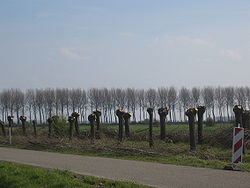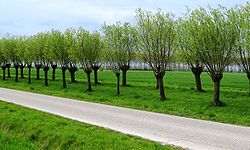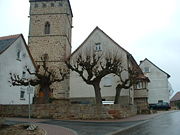
Pollarding
Encyclopedia


Pruning
Pruning is a horticultural practice involving the selective removal of parts of a plant, such as branches, buds, or roots. Reasons to prune plants include deadwood removal, shaping , improving or maintaining health, reducing risk from falling branches, preparing nursery specimens for...
system in which the upper branches of a tree are removed, promoting a dense head of foliage and branches. It has been common in Great Britain and Europe since medieval times and is practiced today in urban areas worldwide, primarily to maintain trees at a predetermined height.
Traditionally trees were pollarded for one of two reasons: for fodder
Fodder
Fodder or animal feed is any agricultural foodstuff used specifically to feed domesticated livestock such as cattle, goats, sheep, horses, chickens and pigs. Most animal feed is from plants but some is of animal origin...
to feed livestock
Livestock
Livestock refers to one or more domesticated animals raised in an agricultural setting to produce commodities such as food, fiber and labor. The term "livestock" as used in this article does not include poultry or farmed fish; however the inclusion of these, especially poultry, within the meaning...
, or for wood. Fodder pollards produced "pollard hay", which was used as livestock feed; they were pruned at intervals of 2-6 years so that their leafy material would be most abundant. Wood pollards were pruned at longer intervals of 8-15 years, a pruning cycle that tended to produces upright poles favored for fence rails and posts as well as boat construction. One consequence of pollarding is that pollarded trees tend to live longer than unpollarded specimens because they are maintained in a partially juvenile state, and they do not have the weight and windage of the top part of the tree.
Older pollards often become hollow, and so can be difficult to age accurately. Pollards tend to grow slowly, with narrower growth rings in the years immediately after cutting.
Practice
As in coppicingCoppicing
Coppicing is a traditional method of woodland management which takes advantage of the fact that many trees make new growth from the stump or roots if cut down. In a coppiced wood, young tree stems are repeatedly cut down to near ground level...
, the tradition of pollarding is to encourage the tree to produce new growth on a regular basis in order to maintain a supply of new wood for various purposes, particularly for fuel. In some areas dried leafy branches are stored as winter fodder for stock. Depending upon the use of the cut material, the length of time between cutting will vary from one year for tree hay or withies, to five years or more for larger timber. Sometimes only some of the regrown stems may be cut in a season – this is thought to reduce the chances of death of the tree when re-cutting long-neglected pollards.
Pollarding was preferred over coppicing in wood-pastures and other grazed areas, because animals would browse the regrowth from coppice stools. Historically, the right to pollard or "lop" was often granted to local people for fuel on common land
Common land
Common land is land owned collectively or by one person, but over which other people have certain traditional rights, such as to allow their livestock to graze upon it, to collect firewood, or to cut turf for fuel...
or in royal forests; this was part of the right of Estover
Estovers
In English law, estovers is wood that a tenant is allowed to take, for life or a period of years, from the land he holds for the repair of his house, the implements of husbandry, hedges and fences, and for firewood....
.
An incidental effect of pollarding in woodland is the encouragement of underbrush growth due to increased levels of light reaching the woodland floor. This can increase species diversity. However, in woodland where pollarding was once common but has now ceased, the opposite effect occurs as the side and top shoots develop into trunk-sized branches. An example of this occurs in Epping Forest
Epping Forest
Epping Forest is an area of ancient woodland in south-east England, straddling the border between north-east Greater London and Essex. It is a former royal forest, and is managed by the City of London Corporation....
in London
London
London is the capital city of :England and the :United Kingdom, the largest metropolitan area in the United Kingdom, and the largest urban zone in the European Union by most measures. Located on the River Thames, London has been a major settlement for two millennia, its history going back to its...
/Essex, UK
United Kingdom
The United Kingdom of Great Britain and Northern IrelandIn the United Kingdom and Dependencies, other languages have been officially recognised as legitimate autochthonous languages under the European Charter for Regional or Minority Languages...
, the majority of which was pollarded until the late 19th century. Here, light levels on the woodland floor are extremely low owing to the thick growth of the pollarded trees.
Pollards cut at only about a metre or so above the ground are called stubs (or stubbs). These were often used as markers in coppice or other woodland. Stubs cannot be used where the trees are browsed by animals, as the regrowing shoots are below the browse line.

Species
As with coppicing, only species with vigorous epicormicEpicormic shoot
An epicormic shoot is a shoot growing from an epicormic bud which lies underneath the bark of a trunk, stem, or branch of a plant.-Epicormic buds:...
growth may be made into pollards. In these species (which include many broadleaved trees but few conifers) removal of the main apical stems releases the growth of many dormant buds under the bark on the lower part of the tree. Trees without this growth will, of course, die without their leaves and branches. Some smaller tree species do not readily form pollards, because cutting the main stem stimulates growth from the base, effectively forming a coppice stool instead. Examples of trees that do well as pollards include broadleaves such as beech
Beech
Beech is a genus of ten species of deciduous trees in the family Fagaceae, native to temperate Europe, Asia and North America.-Habit:...
es (Fagus), oak
Oak
An oak is a tree or shrub in the genus Quercus , of which about 600 species exist. "Oak" may also appear in the names of species in related genera, notably Lithocarpus...
s (Quercus), maple
Maple
Acer is a genus of trees or shrubs commonly known as maple.Maples are variously classified in a family of their own, the Aceraceae, or together with the Hippocastanaceae included in the family Sapindaceae. Modern classifications, including the Angiosperm Phylogeny Group system, favour inclusion in...
s (Acer), black locust or false acacia (Robinia pseudoacacia), hornbeams (Carpinus), lindens or limes (Tilia
Tilia
Tilia is a genus of about 30 species of trees native throughout most of the temperate Northern Hemisphere. The greatest species diversity is found in Asia, and the genus also occurs in Europe and eastern North America, but not western North America...
), planes (Platanus
Platanus
Platanus is a small genus of trees native to the Northern Hemisphere. They are the sole living members of the family Platanaceae....
), horse chestnuts (Aesculus
Aesculus
The genus Aesculus comprises 13-19 species of woody trees and shrubs native to the temperate northern hemisphere, with 6 species native to North America and 7-13 species native to Eurasia; there are also several hybrids. Species are deciduous or evergreen...
), mulberries (Morus
Morus
Morus may refer to:* Morus , a genus of trees* Morus , a genus of seabird in the family Sulidae* Thomas Morus, alias Thomas More, a philosopher...
), Redbud (Cercis canadensis), Tree of Heaven (Ailanthus altissima) and willows (Salix); also a few conifers, such as yew
Taxus
Taxus is a genus of yews, small coniferous trees or shrubs in the yew family Taxaceae. They are relatively slow-growing and can be very long-lived, and reach heights of 1-40 m, with trunk diameters of up to 4 m...
s (Taxus).
The technique is also used in Africa
Africa
Africa is the world's second largest and second most populous continent, after Asia. At about 30.2 million km² including adjacent islands, it covers 6% of the Earth's total surface area and 20.4% of the total land area...
for Moringa
Moringa oleifera
Moringa oleifera, the word Moringa probably came from dravidian language Tamil and commonly referred to as "Shojne" in Bengali, "Munagakaya" in Telugu,"Shenano" in Rajasthani,...
trees, to bring the nutritious leaves into easier reach for harvesting. Pollarding is also used in urban forestry
Urban forestry
Urban forestry is the careful care and management of urban forests, i.e., tree populations in urban settings for the purpose of improving the urban environment. Urban forestry advocates the role of trees as a critical part of the urban infrastructure...
in certain areas for reasons such as tree size management, safety and health concerns. It removes rotting or diseased branches for the overall health of the tree, living and dead branches that could harm property and people, as well as expanded foliage in spring for aesthetic, shade and pollution concerns. Trees may be "rejuvenated" by pollarding – for example Bradford pear (Pyrus calleryana "Bradford"), a beautiful flowering species when young, but brittle and top-heavy when older.
Oaks, when very old, can form new trunks from the growth of pollard branches - i.e. surviving branches which have split away from the main branch naturally.

Origin and usage of term
Poll was originally a name for the top of the head, and to poll was a verbVerb
A verb, from the Latin verbum meaning word, is a word that in syntax conveys an action , or a state of being . In the usual description of English, the basic form, with or without the particle to, is the infinitive...
meaning "to crop the hair". This use was extended to similar treatment of the branches of trees and the horns of animals. A pollard simply meant someone or something that had been polled (similarly to the formation of "drunkard" and "sluggard"); for example, a hornless ox
Ox
An ox , also known as a bullock in Australia, New Zealand and India, is a bovine trained as a draft animal. Oxen are commonly castrated adult male cattle; castration makes the animals more tractable...
. Later the noun
Noun
In linguistics, a noun is a member of a large, open lexical category whose members can occur as the main word in the subject of a clause, the object of a verb, or the object of a preposition .Lexical categories are defined in terms of how their members combine with other kinds of...
pollard became used as its own verb: "pollarding". "Pollarding" has now largely replaced "polling" as the verb in the forestry sense. Pollard can also be used as an adjective: "pollard tree".
See also
- CoppicingCoppicingCoppicing is a traditional method of woodland management which takes advantage of the fact that many trees make new growth from the stump or roots if cut down. In a coppiced wood, young tree stems are repeatedly cut down to near ground level...
- Tree toppingTree toppingTree topping is the practice of removing whole tops of trees or large branches and/or trunks from the tops of trees, leaving stubs or lateral branches that are too small to assume the role of a terminal leader. Other common names for the practice include hat-racking, heading, rounding over, and...
- Fruit tree pruning
- PleachingPleachingPleaching is a technique to weave the branches of trees into a hedge or to form a quincunx. Commonly, deciduous trees are planted in lines, then pleached to form a flat plane on clear stems above the ground level. Branches are woven together and lightly tied...

